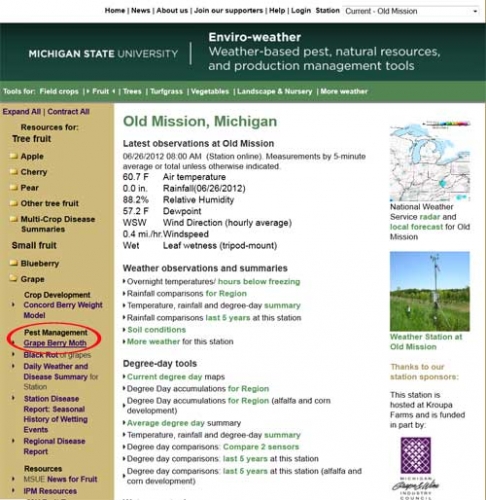Mid-season grape berry moth management for 2012
Growers managing vineyards for the 2012 harvest should now consider protecting berries from grape berry moth. The MSU Enviro-weather grape berry moth model can assist with timing of control measures.
The MSU Enviro-weather grape berry moth model is predicting the start of the second generation egglaying this week in southwest Michigan. This is based on 810 growing degree days accumulated since the date of wild grape bloom, which was in mid- to late May across the region.
Growers who are managing their vineyards for harvest in 2012 should now consider protecting berries from grape berry moth in vineyards, as the second generation of this pest can infest berries and lead to later cracking and splitting of fruit as the berries start to swell.
If you recorded the date of wild grape bloom, that can now be used to predict the start of second generation egglaying at your location using the MSU Enviro-weather grape berry moth degree day model. To access the model, go to www.enviroweather.msu.edu, pick a station closest to you, select “Fruit” at the top and then select “Grape Berry Moth” under the Grape folder, located on the left-hand side of the screen (see image below).

MSU Enviro-weather grape berry moth model, located on the Fruit
section under the Grape folder.
This season provides a good example of why a degree day model might help growers time applications better than a calendar approach. In 2010 the model was predicting the start of this generation in southwest Michigan at 810 degree days on July 14, and we are over two weeks earlier using the model this year.
The predicted start of egglaying is the optimal timing for application of insecticides that are active on eggs and young larvae, such as Intrepid, Altacor and Belt. For these products, excellent cluster coverage is essential, but once it is on the clusters, long residual control of grape berry moth (two to three weeks) and rainfastness are achieved. For products that are broad-spectrum that are best timed for egg hatch, applications should be delayed to be timed 100 degree days after 810, i.e., at 910 degree days from wild grape bloom. For the locations in far southwest Michigan, this is expected to be closer to Independence Day (July 4).
The MSU Enviro-weather grape berry moth model is a tool to assist with timing of control measures. It is not designed to replace regular vineyard scouting, which can show the exact date of wild grape bloom at your farm. Growers should also be checking clusters for the level of infestation by grape berry moth through the season, to provide indications of whether it is worth the expense of a pesticide application.
In our recent research trials, spray programs that timed applications for berry moth control based on the degree day model outperformed those that used a calendar approach. This was the case for broad spectrum insecticides, and even better control was achieved when we tested degree-day timed sprays using some of the new insecticides that are highly active and long-lasting for berry moth control. For example, a program using Intrepid at 8 oz/acre applied at 810 degree days followed by Altacor at 3 oz/acre applied at 1,620 degree days provided similar or slightly better control than a Sevin and Imidan program in the mid- and late season timings. Altacor also has activity against Japanese beetles, making it a useful tool for mid-season control when both pests are present. Belt has a similar mode of action to Altacor and is less expensive, but it is more selective and does not provide the Japanese beetle control. Other pest insects may be important in your vineyards, but if you are focusing on berry moth control, degree day-timed applications of long-lasting and active insecticides applied with excellent coverage provides an effective program to reduce pressure from this pest.
Finally, a word of early warning for growers with vineyards that will be harvested this year. The exceptionally early and warm weather this summer is setting up conditions that will favor a fourth generation of grape berry moth in the late part of the summer. If 1,620 degree days falls before early August (and it looks like it will), this means that the eggs laid around that time will be primed to develop through all the way to moths, rather than stopping at the pupa stage for overwintering. After the recent experience during hot summers (think 2010), we are better able to predict this and will provide some updated warnings as that time of the season approaches.
Dr. Isaacs’ work is funded in part by MSU’s AgBioResearch.



 Print
Print Email
Email


